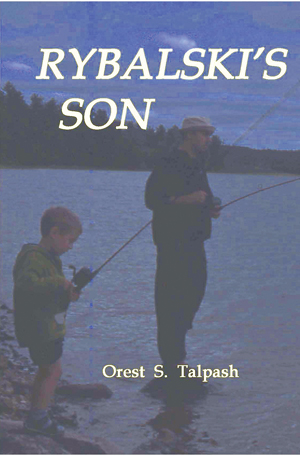Rybalski’s Son – Preview
to Toronto Book Launch at UNF
By
Halia Wawryshyn
A recently published book, Rybalski’s Son
by Orest Talpash of Edmonton, is
a captivating addition to Ukrainian Canadian Literature. A real page-turner, this book reads like a novel,
but it is actually a series of twelve related stories.
 The first story takes place
in 1896 in the western Ukrainian village of
Germakivka,
then part of the Austro-Hungarian Empire of Franz Josef. Succeeding stories take place at ten-year
intervals, the last one in Edmonton in
2006.
The first story takes place
in 1896 in the western Ukrainian village of
Germakivka,
then part of the Austro-Hungarian Empire of Franz Josef. Succeeding stories take place at ten-year
intervals, the last one in Edmonton in
2006.
Each story deals with one
central character who is a member of the extended Rybalski Family, and each one
deals with the different circumstances unique to his time and place. The second
story, which takes place in September 1906, tells of Vasyl Rybalski’s
experiences in Ethelbert, Manitoba, while the next story, set in 1916, deals
with life in the village of Ustia Biscupske in Halychyna. The next story in 1926 sees a family member
in Canada
again, this time in Pine River, Manitoba,
while the following one takes place in Preeceville, Saskatchewan. In 1946, Theodosij Rybalski is living through
very different experiences in the aftermath of World War II in Aschaffenburg, Germany .
.
Back in Canada, in
Weyburn, Saskatchewan in
1956, in Myrnam, Alberta in
1966, and Edmonton, Alberta in
1976, the family members appear to live in peace and tranquillity as compared
to what other members endured during the war years. Yet, even the stories of
family in Canada, in
which each member deals with his problems and changed circumstances, are
riveting.
In 1986, the story is about
retired teachers, Steven and Sophia Rybalski, living in the Ilarion Seniors’
Residence in Saskatoon, Saskatchewan,
who visit Ukraine. Their trip is a 50th wedding anniversary
present from their children. The
comments and observations of the couple and their fellow travellers, thirteen
other retired seniors from Saskatchewan,
are sure to elicit a smile and even a chuckle, as so many of us have shared the
same experiences while visiting Ukraine in
the 1980s. Sophia wonders why people
smile when she speaks – whether it is because her language “is a century
removed from its roots, or that their Ukrainian is so full of Russian that they
don’t even recognize that we speak a ‘pure’ Ukrainian.”
In the story set in 1996,
Jason Dobrowolski doesn’t even speak Ukrainian, but loves borscht, varennyky
and holubtsi and knows all about the kozaky from his
great-grandmother’s stories. He stays with Uncle Rybalski and his wife while
attending the University of
Alberta and
reluctantly attends a family wedding at his aunt’s prodding. There, he meets
many Rybalski family members that he barely knows. Luckily, he also meets
Andrea Andreychuk, who promises to teach him to dance if he goes with her to
the Ukrainian Students’ Club social.
Twenty-two-year-old Mark
Rybalski is a rudderless student in 2006 at the University of
Alberta
with a girlfriend and a life his lawyer father disapproves of. His Grandpa
Davidiuk has a very positive influence on his life and when Mark, a history
buff, discovers that over 100 years ago the Rybalskis were landowners who even
had a coat of arms, Mark begins to think of himself and his background in
totally different terms.
In an epilogue, Mark, now a
grad student, writes to his parents from Kyiv, which he loves. He is next going
to tour the area south of Borshchiv and take pictures around Germakivka and
Ustia Biscupske.
All these fascinating
characters are fictitious, yet the “descriptions of the villages, sites, and
historical references are accurate and true.” The author has done an amazing
amount of historical and geographical research and lists many selected sources.
These twelve stories can
also be read as a historical novel, as they present the saga of one family,
showing the history of Polish and Ukrainian relations and describing how
families lived in Ukraine,
and then how they adapted to Canada. The events in the stories are often treated
with a subtle sense of humour, and with very few words vivid pictures emerge.
This panorama of over 100
years deals with late 19th-century life in Ukraine,
and touches on First and Second World War experiences in Ukraine and
Germany. It
shows adaptations made by Ukrainian immigrants in the Early 20th Century and
later, those who arrived in the post WWII period. The author’s keen
observations make the young people of the recent decade totally believable.
Rybalski’s Son is
an excellent tool in teaching young people the history and the sociology of the
past century.
The author of this
remarkable book is Dr. Orest Talpash, a retired Clinical Professor of
Dermatology who lives in Edmonton.
His family came to Canada in
the late 1890s, and, all his life, he has enjoyed listening to stories and
anecdotes. Snippets of these have entered this magnificent book.
After reading the book,
Daria Diakowsky, of the Ukrainian National Federation Toronto Branch – Resource
Centre, immediately called Orest in Edmonton and
arranged a date for a book launch in Toronto. It takes place on Wednesday, June 2, at 7:30 pm.,
held at the UNF Toronto Community Centre, 145
Evans Ave. Dr. Orest Talpash will
present his new book at the event.
PHOTO
Orest Talpash
 The first story takes place
in 1896 in the western Ukrainian
The first story takes place
in 1896 in the western Ukrainian  The first story takes place
in 1896 in the western Ukrainian
The first story takes place
in 1896 in the western Ukrainian  .
.